D7200 Vs D7000 Vs D500 for Wildlife Photography
For several years, it appeared that Nikon had abased the idea of a successor to the D300s, with rumors of a D400 materializing into the D7000, D7100, and D7200. And then, almost 7 years after the announcement of the D300s, Nikon surprised united states with a new, professional-level APS-C camera: the Nikon D500. Packed with powerful features, a new processor, a remarkable AF system, and a new (but lower resolution) sensor, the D500 as well doesn't come cheap, at virtually $2000 for the torso. In some cases, the college resolution sensor of the D7200 will provide sharper, college resolution photos than the D500, and it is lighter, more compact, and about $1000 less expensive to kicking. So which one is right for you? (SKIP to Conclusion)
Nikon D500 vs D7200: What's the Difference?
Let's begin past taking a look at where some of the important differences in specs, which I'll delve into in greater detail beneath.
| Nikon D500 | Nikon D7200 | |
|---|---|---|
| | | |
| Price (body) | $1997 | $1097 |
| Price With Kit Lens | $3067 with 16-80mm f/ii.8-4E VR | $1397 with xviii-140mm f/3.five-v.half-dozen VR |
| Trunk Material | Magnesium Alloy and Carbon Fiber | Partial Magnesium Alloy Frame, Plastic |
| Grit/Weather Sealed Body | Yes | Yes |
| Sensor Resolution | 20.9 Megapixel | 24.ii Megapixels (Sony) |
| Anti-Aliasing Filter [OLP] (Reduces sharpness, prevents moire) | NO | NO |
| ISO Range | 100 - 51200 | 100 - 25600 |
| Full AF Points | 153 (55 selectable) | 51 |
| Cross-Type AF Points | 99 (35 selectable) | 15 |
| AF Motor In Body (For Using Older AF Lenses) | Yep | Yes |
| AF Light Level Range | -4 to +19 EV | -three to +19 EV |
| Autofocus Fine Tuning Adjustments | YES | YES |
| Shutter Speed Range | 1/8000th - 30 sec. +bulb | 1/8000th - 30 sec. +bulb |
| Max Frame Rate | x fps | half dozen fps (vii shots in 1.3x crop mode) |
| Max RAW Burst (buffer size) | 79 shots 14-bit 200 shots 14-flake compressed | 18 shots 14-fleck compressed |
| Max JPG Flare-up (fine, Large) | 500+ | 100 |
| Wink Sync Speed | ane/250th sec. | 1/250th sec. |
| Wireless Flash With Built-in Commander | NO (no born flash) YES (with additional equipment) | YES |
| Nikon RADIO Wireless Wink Uniform | Yeah | NO |
| Motorcar FP Flash Mode (High Speed Sync) | Yep | Aye |
| Media Slots | 1 SDXC 1 XQD | 2 SDXC |
| Quick Access User Modes (Saved U1, U2 programs) | No | Yes |
| LCD Size | 3.2" 2,359,000 pixels | iii.2" 1,228,800 pixels |
| LCD Articulated | YES | No |
| LCD Touchscreen | YES | No |
| Built-in GPS | No | No |
| Bluetooth | Yep (v4.1) | No |
| Built-in WiFi | YES | Yeah |
| Torso Weight | 760g (no battery) | 675g (no bombardment) |
| Torso Size | 147 mm 10 115 mm 10 81 mm | 136 x 106.v x 76 mm |
| Battery Life | 1240 CIPA Standards | one,110 shots CIPA Standards |
| Viewfinder Coverage | 100% i.0x Magnification | 100% Frame .94x Magnification |
| Video Codec | MPEG-4 / H.264 .mov | MPEG-4 / H.264 .mov |
| Video Resolutions | 3,840 10 2,160 (4K: 30, 25, 24 fps) 1920 x 1080 (60, 50, 30, 25, 24 fps) 1280 x 720 (60, 50 fps) 640 x 424 (30, 25 fps) | 1920 x 1080 (60, fifty, 30, 25, 24 fps) 1280 x 720 (threescore, l fps) 640 x 424 (30, 25 fps) |
| Digital Stabilization for Video | YES (Reduces image surface area; not available for 4K resolution) | NO |
| Video Length Limit | 29 min 59 sec. | 29 min 59 sec. |
| Headphone Jack | Yes | Aye |
| Internal Mic | Stereo | Stereo |
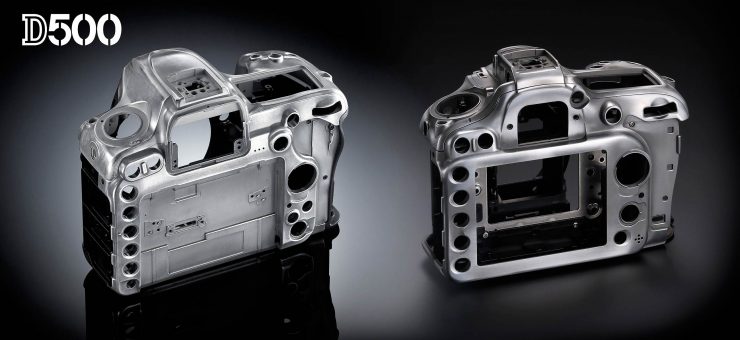
Build Quality
Both cameras are solidly built, with partial magnesium blend frames, finished with carbon fiber or polycarbonate to keep them light weight. Both cameras accept weather condition sealing to protect against raindrops and dust (though many lenses are not weather sealed, and then circumspection is recommended). They'll both stand up to plenty of travel and rough treatment.
Notwithstanding, the D7200 is all the same a compact SLR, while the D500 is a standard size SLR. In more precise terms, this means that the D500 is about 1cm taller and 1cm wider than the D7200, and well-nigh a one-half centimeter thicker, making it feel considerably larger in the mitt (it's the same size equally the old D300, a fleck taller than the D800). The difference in weight is non dramatic, only it is significant: almost 85g. 85 grams, if you don't take a good feel for it, is about the mass of an average apple tree (an actress-big craven egg might be every bit much equally 60-70g). It's still less than half the weight of even a small prime number lens, similar the 35mm f/1.8G, which weighs 200g, but it's enough weight that you'll notice the difference.
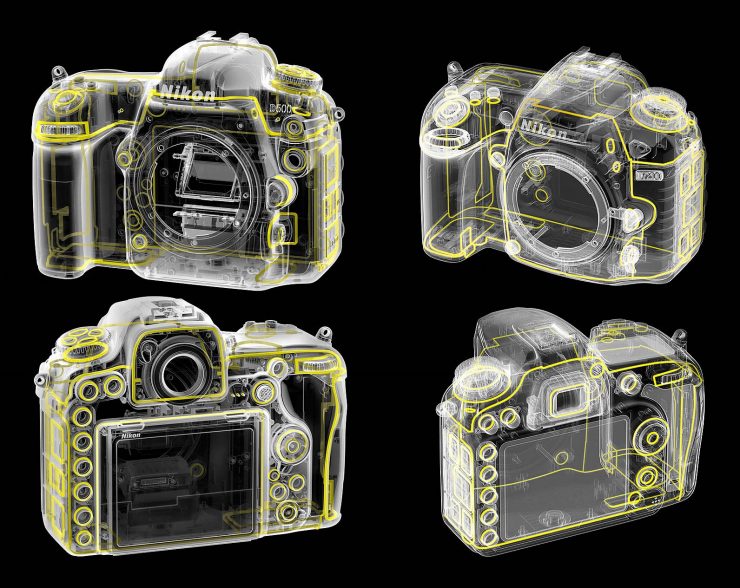
The Sensors : Resolution and Low Light Performance
Some people were surprised to observe that the D500's sensor has lower resolution (20.ix megapixels) than that of the older, less expensive D7200 (24.3 megapixels). There are a few reasons why Nikon made this choice.
Outset, and most chiefly, is Nikon's concentration on loftier-ISO performance with the D500. More than pixels on a sensor means smaller pixelsane Technically speaking, these are properly called photo sites or receptors on the sensor, but since we're talking about the sensors in terms of mega-pixels, it'south fair to be loose with terminology . Smaller pixels collect less lite, but the sensor's electronics still generate background noise. This results in a worse signal to noise ratio (like a quiet voice talking in the automobile over the road dissonance), and thus, more digital noise in the image that results, peculiarly at high ISOs (where the sensor tries to get past with even less low-cal).
The D500 has fewer 'pixels' on its sensor, so they're larger. As a event2 At least, in role. New sensor applied science all effectually and signal processing also play an of import role. , the D500 has a pinnacle native ISO of 51200, compared to the 25600 of the D7200: a total f-stop of deviation. Nosotros find that the D500'south noise at ISO 6400 is comparable to the D7200's at ISO3200, when shooting RAW, though the D7200'due south noise is slightly less pronounced and the D500 remains slightly more than contrasty.
2d, Nikon adult the D500 to compete with the Canon 7D Mark Two, which can shoot ten frames per second. That produces a lot of information for any camera to deal with. At higher resolutions, cameras produce larger files, which are harder to motion apace through the information pipeline to storage. A lower resolution sensor's smaller files are easier for the camera to deal with at loftier speeds, making it easier for Nikon to attain that 10 frame per second milestone.
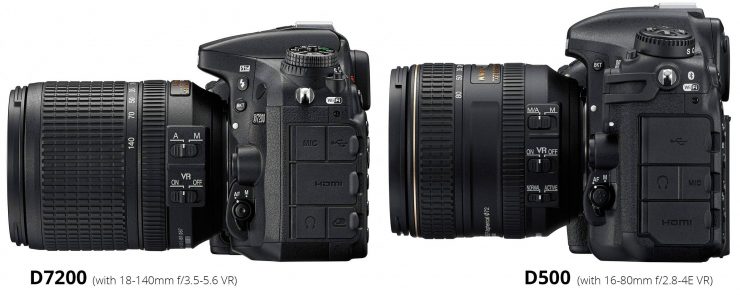
And finally, for most photographers, the departure in resolution between 21 and 24 megapixels but isn't very meaning in real-world use. Remember that most of us use figurer monitors that are no larger than 4K resolution (nearly 8 megapixels), just the vast majority use full Hard disk (1080p is only 2 megapixels), and very few photographers print these days. And if you're resizing an image from 21 megapixels down to x% of its original size, all of the fine differences in particular will be thrown out anyway.
Merely if you practice print? Then yous'll have to impress Big to be able to see these differences… probably 16 x 24 inches or perhaps larger.
And that's bold that yous are able to capture a difference to begin with. Only the sharpest lenses have high plenty resolution to brand a difference, and even then, but when shot from a tripod at the lens' sharpest apertures, with no vibrations from the wind, ground, shutter, etc. A full frame sensor with the same pixel density of the D500'south twenty.nine megapixel sensor would hold 46.v megapixels, and Nikon has already admitted that not many lenses can meet the demands of the D800/D810's 36 megapixel sensor.
Who works like this, regularly? Mural photographers often practice, and and so do some commercial/studio photographers and fine-art photographers. Merely journalists, consequence photographers, sports photographers, and hobbyists by and large do non.
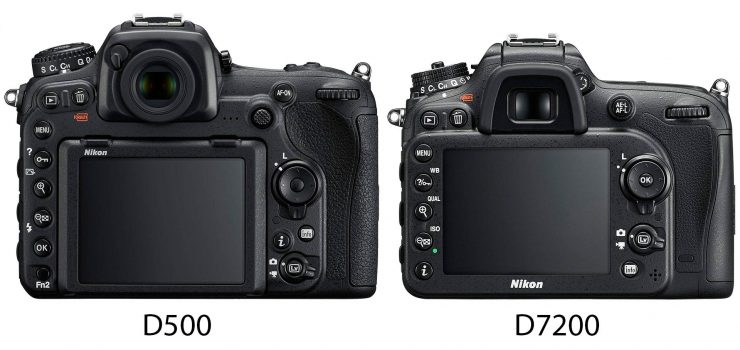
Speed
While the D7200 is no slouch, the D500 takes activeness photography to a new level for Nikon APS-C cameras: it can shoot at 10 frames per second, and just every bit importantly, information technology can shoot that fast for quite a while. The D7200 tin shoot at six frames per second, only if you lot're shooting RAW, it can simply shoot 18 shots in a row (three seconds) earlier the buffer is full and it needs a break to write to the SD card. On the other manus, the D500 tin shoot the same compressed RAW files for 20 seconds: 200 continuous shots! And while most photographers don't have any reason to shoot bursts that long, we practise frequently shoot many shorter bursts within a few minutes time, which can besides crusade bug with a small-scale buffer.
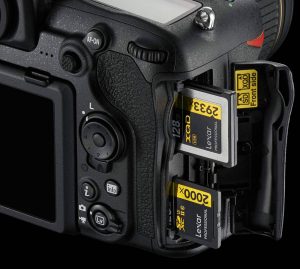
There is a caveat here, though. The Nikon D500 has an XQD menu slot, which supports data transfers across 300 MB/south. If you're using the camera'southward SD card slot, you probably won't get anything similar this kind of buffer operation (an older Nikon video shows the difference in write speeds). If you want the XQD performance, y'all'll demand to budget a couple hundred dollars more for the cost of a fast bill of fare (prices seem to range from $100–400 for the fastest XQD cards, if y'all tin can find them at all).
Of grade, if y'all're willing to shoot JPG, then the D7200 has no trouble, as it is able to shoot bursts of more than 100 shots in that format.
Who needs this? Journalists, action photographers, outcome photographers, wildlife photographers, and anyone else who needs to capture images in copious quantities very apace. Travel photographers, maybe. Portrait, landscape, product and commercial photographers? Probably not.
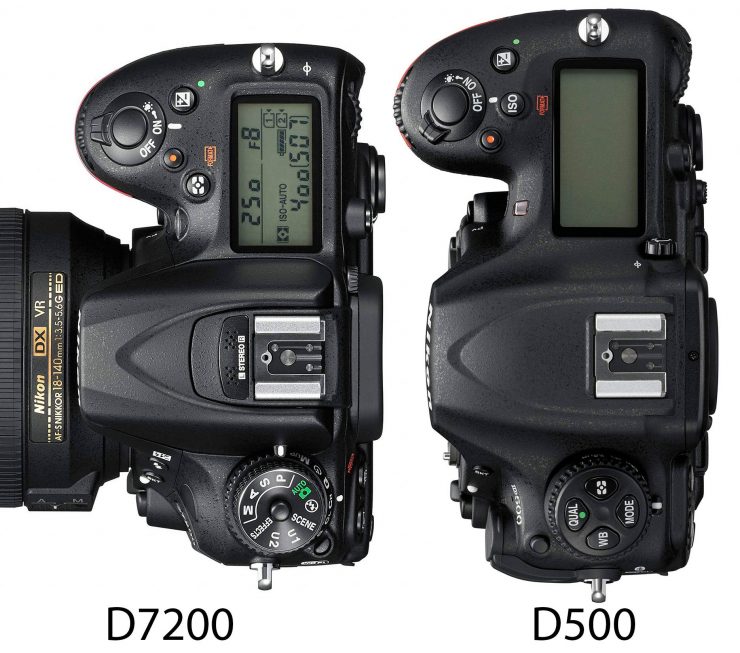
Autofocus System
The D7200 has had one of the best autofocus systems bachelor in an APS-C camera: the 51-point Multi-CAM 3500DX II, which is shared with the flagship Nikon D4s. Not surprisingly, though, the D500 has managed to ameliorate on information technology with the 153-point Multi-CAM 20K, which information technology shares with the upcoming Nikon D5.
Though there is a big increase in the overall number of autofocus points, the real improvement in the D500'south organisation is in the number of cross-blazon points, which has increased from xv in the D7200 to 99, though but 35 are can exist selected manually. If you're non sure what cross-type points are, I recommend watching our curt video on cross-type points for a quick explanation. In short, they're much more reliable than standard AF points.
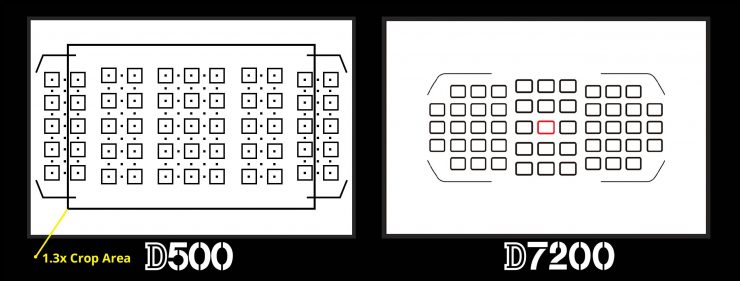
Beyond the number of AF points, the AF organisation of the D500 has become more sensitive for use in depression light; it can focus in light levels of -4EVs (almost too dark for the human eye to run across), just half of the light level in which the D7200'due south AF arrangement can focus (-3 EVs). Both are very impressive, merely if you've always failed to grab focus in dim low-cal, you lot'll sympathise how of import this actress degree of insurance is for event-shooters.
That said, for all merely the about hardcore of sports and action photographers, if you have problems getting in-focus images with the D7200's AF system, you should probably expect at your own technique rather than the photographic camera for issues. If you are like many photographers and select a single AF point to track a subject (or compose your image by selecting the near middle in a portrait, for case), then the boosted AF points of the D500 will be of minimal value, since merely 55 of them can be manually selected (just 2 more than the D7200's 53).
Who will find this useful? Again, sports and action photographers, probably not portrait, landscape, or commercial photographers.
Video
It is tempting to just say "The Nikon D500 can shoot 4K video and the D7200 can't" and exit it at that. While the fact is true, there are some ugly details.
The D500 shoots Full HD video much as yous would expect, using the full width of the frame to capture xvi:9, 1920 10 1080 video. You also have the selection of capturing that video from a 1.3x cropped section of the sensor (which is, of class, already 1.5x cropped compared to an FX sensor).
Notwithstanding, when the D500 captures 4K video, you are forced to apply a cropped section of the sensor that is even smaller than the 1.3x cropped section that is optional at 1080p. It tin can be seen in our graphic, below:
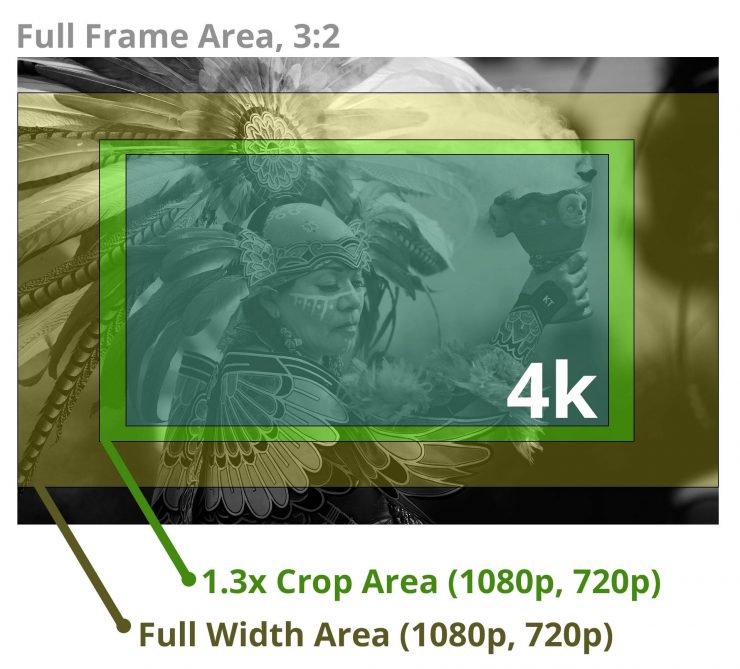
This may be perfectly adequate for those who merely shoot telephoto video; it provides remarkably high resolution video and a roughly 1.5x crop, making a 200mm lens perform like a 450mm lens (1.5x crop + 1.5x ingather). However, for those times when you want to shoot broad bending, y'all'll need to utilise an ultra-wide angle lens just to become shut; while a 16mm lens might normally give y'all a full-frame 24mm lens's field of view, y'all'll demand an 11mm lens to get something virtually equivalent if you're shooting 4k.
Then, if yous're looking for a camera but to shoot 4K video, the D500 is inappreciably ideal.
Withal, if you're more often than not shooting 1080p or 720p, then the D500 has one more play tricks up its sleeve: digital prototype stabilization, which can be used in conjunction with optical image stabilization. You will lose a fiddling bit of the frame, but the sensor has plenty of resolution to spare, so at that place's no loss in resolution, and the addition of digital stabilization goes a long mode towards giving yous smooth, jitter-free video. Nikon has also (finally) added electronic aperture control while shooting video, also as exposure smoothing capabilities when moving from dark to bright areas (using auto ISO and electronic discontinuity control).
The Nikon D7200, unfortunately, does not have electronic aperture command, nor digital image stabilization. It does, however, have 1.3x crop mode, like the D500, and both can output video to an external recorder.
Additional Considerations
There are, naturally, several small-scale differences in the layout and handling of the controls between the 2 cameras. Near are non very significant. It is worth mentioning, though, that the D500 has an articulating touch-screen, while the D7200'south monitor is fixed position and not affect sensitive.
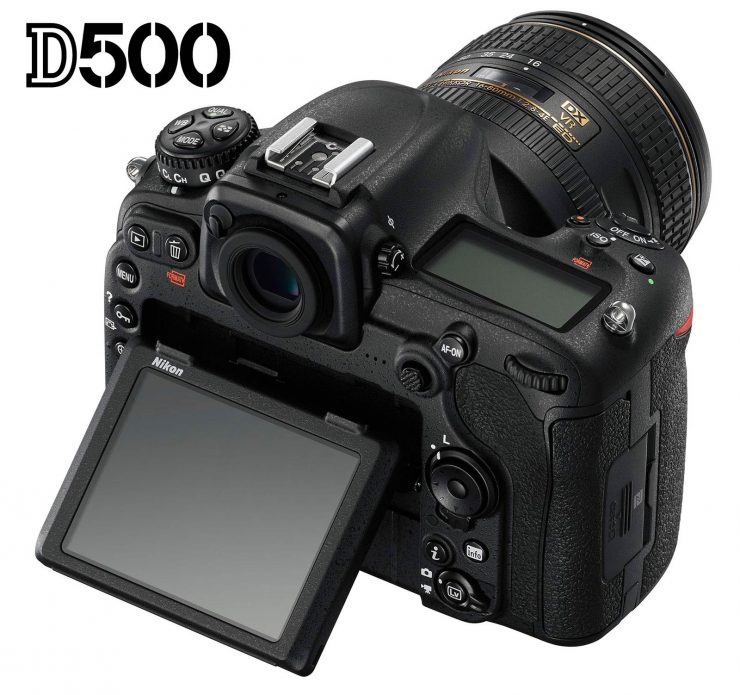
The Nikon D7200 does not support the new Nikon radio-controller (WR-R10/WR-A10) and SB-5000 wink system, which can command up to eighteen speedlights. However, there are countless 3rd party radio-triggering systems already available on the market place, from Pocket Wizards and RadioPoppers to the Nissin Air 1 Commander and the Phottix Odin, and then this should exist only a minor consideration for almost people.
Conclusions
The new features of the Nikon D500 will primarily benefit photographers who shoot events and long bursts of activity, especially those who shoot them in depression lite with high ISO. Those photographers will get ameliorate operation with the D500: meliorate speed, more reliable autofocus, and less digital dissonance. This all comes at the cost of a larger trunk with more weight and potentially lower resolution images.
However, if you normally shoot at low ISO, and if your master involvement is not fast moving action, then the D7200 will give you lot equally adept results, and in some cases, information technology may give y'all ameliorate images. If you shoot with impeccable technique3 This generally means shooting from a sturdy tripod with a remote release or timer, with the photographic camera's mirror locked up to reduce vibrations, at least. with a acme quality lens ready in its sharpest aperture range, the D7200'southward sensor is capable of capturing more particular than the D500's.
Y'all Should Buy the Nikon D500 If…
- you plan to shoot a lot of action like: sports, news events, weddings, wildlife
- yous plan to shoot events in a dark setting: concerts, clubs, weddings, wildlife
- you need to shoot 4K video, particularly telephoto, or digitally stabilized Hd Video
- you want to use Nikon's SB-5000 flashes and radio trigger arrangement
- you want a touch-screen and/or articulated rear LCD
You Should Purchase the Nikon D7200 If…
- yous shoot landscapes or other detail oriented genres at low ISOs, including: studio portraits, product images, still-life works
- you lot hike or travel with your camera and would adopt a lighter weight trunk that is still weather sealed
- you shoot action photography but don't need a total 10 frames per second (the D7200 is a very capable activity camera)
If you do make up one's mind to buy either one and take found this article helpful, please back up united states by purchasing your camera from whatsoever of the links found in this text, or from the stores listed hither: Amazon.com, Adorama Photo, Best Buy (online), or B&H Photograph.
Buy the Nikon D7200: From Amazon.com | From B&H Photo | From Adorama
Buy the Nikon D500 : From Amazon.com | From B&H Photo | From Adorama
Questions? Comments?
I've attempted to concentrate on the most important differences between these cameras in practical utilise for photographers who shoot RAW files, but in that location are other minor differences. They may or may non be relevant to the mode you shoot. Withal, if you still have whatsoever questions about which camera you lot should buy, please feel free to ask me in the comments department below! I'll answer as chop-chop as I can.
0 Response to "D7200 Vs D7000 Vs D500 for Wildlife Photography"
Post a Comment